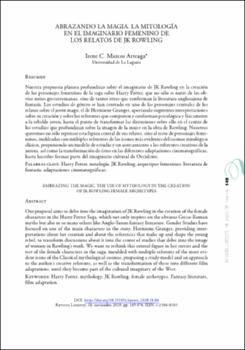Abrazando la magia. La mitología en el imaginario femenino de los relatos de JK Rowling
Autor
Marcos Arteaga, Irene C.Fecha
2020Resumen
Nuestra propuesta plantea profundizar sobre el imaginario de JK Rowling en la creación
de los personajes femeninos de la saga sobre Harry Potter, que no sólo se nutre de los obvios
mitos grecorromanos, sino de tantos otros que conforman la literatura anglosajona de
fantasía. Los estudios de género se han centrado en uno de los personajes centrales de los
relatos sobre el joven mago, el de Hermione Granger, aportando sugerentes interpretaciones
sobre su creación y sobre los referentes que componen y conforman psicológica y físicamente
a la rebelde joven, hasta el punto de transformar las discusiones sobre ello en el centro de
los estudios que profundizan sobre la imagen de la mujer en la obra de Rowling. Nosotros
queremos no sólo repensar esta figura central de sus relatos, sino al resto de personajes femeninos,
moldeados con múltiples referentes de los iconos más evidentes del cosmos mitológico
clásico, proponiendo un modelo de estudio y un acercamiento a los referentes creativos de la
autora, así como la transformación de éstos en las diferentes adaptaciones cinematográficas,
hasta hacerlos formar parte del imaginario cultural de Occidente. Our proposal aims to delve into the imagination of JK Rowling in the creation of the female
characters in the Harry Potter Saga, which not only inspires on the obvious Greco-Roman
myths but also in so many others like Anglo-Saxon fantasy literature. Gender Studies have
focused on one of the main characters in the story, Hermione Granger, providing interpretations
about her creation and about the references that make up and shape the young
rebel, to transform discussions about it into the center of studies that delve into the image
of women in Rowling’s work. We want to rethink this central figure in her stories and the
rest of the female characters in the saga, moulded with multiple referents of the most evident
icons of the Classical mythological cosmos, proposing a study model and an approach
to the author’s creative referents, as well as the transformation of these into different film
adaptations, until they become part of the cultural imaginary of the West.





